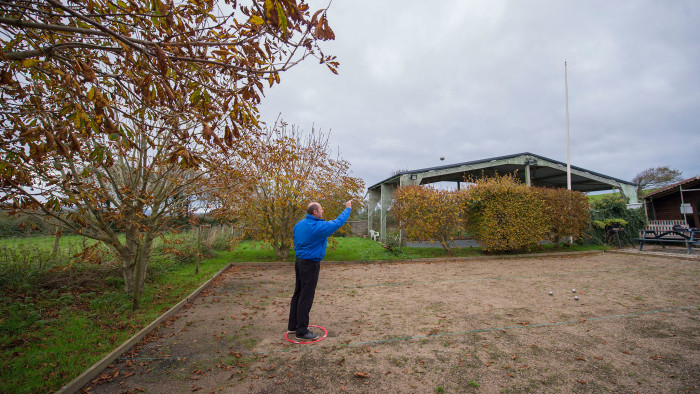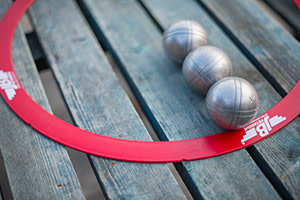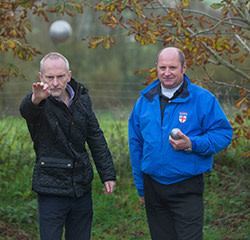FT Masterclass: Pétanque with Mike Pegg

Simply sign up to the Life & Arts myFT Digest -- delivered directly to your inbox.
Rural Devon doesn’t feel quite right for a session working on my pétanque skills with one of the country’s leading players. The modern form of the game originated in Provence more than 100 years ago, and I was hoping for something altogether more French for my lesson with Mike Pegg, Britain’s only international pétanque umpire.
Instead, we have arranged to meet at the Pig on the Hill pub near Bideford, which has its own pétanque club at the bottom of the car park. Pegg, 61, who has been involved in the sport for 30 years, tells me that in fact the southwest can feasibly claim historical links to the game, stretching back to 1588. “Francis Drake used cannonballs to play on Plymouth Hoe as the Armada approached, so it wasn’t a bowls match as everybody thinks. If he was throwing metal rather than wooden balls, it must have been pétanque.”
Either way, it’s a bitterly cold day and several chickens have wandered on to our playing area. They’ve escaped from a pen in the pub garden and are investigating the brightly coloured jack, which is the target ball in pétanque.
Confusion over the name of the game is common, according to Pegg. “Many people call it boules but that is a collective term for ball-throwing games played in different countries. Bocce uses wooden balls and originated in Italy, the English play bowls, while boule lyonnaise is another version, from around Lyon.”

The English Pétanque Association, of which Pegg is president, has 2,700 members and the country is ranked 17th in the world; according to a 2009 survey, there are 583,000 registered pétanque players globally. “The French are number one but they are being pressed hard by Thailand, who now have two world champions,” says Pegg. “The queen mother of Thailand, Princess Srinagarindra, enjoyed the game so much on a trip to Europe in the 1970s that she took a set of balls home with her. The Thai people then took the game to their hearts and it’s really taken off.”
Once we’ve shooed away the chickens, Pegg explains how to play. The rules are relatively straightforward. Each player has three metal balls to throw and, as with bowls, the ball closest to the jack wins the “end”, or round. Each match consists of many ends, until a player reaches 13 points and wins. Each set displays different markings, so that the balls can be identified more easily on the ground during the heat of a match. The metal balls, or boules, measure up to 8cm in diameter and weigh a maximum of 800g. You can buy a cheap set for under £50 but serious players often spend up to £200 for higher-quality metal. The only other piece of kit is a 50cm-wide plastic circle, placed on the ground at the throwing end of the terrain. This plastic circle is “new technology” in pétanque, replacing the hand-drawn circle favoured by the French, says Pegg. Players must keep both feet within the circle when they throw the ball or a foul is called.

Pegg allows me to start the game by tossing the jack about 8m down the pitch. Picking up my first metal ball, I’m surprised by the weight, sitting heavy in the palm of my hand.
“Grip it with your four fingers because a thumb can affect your release action and affect the direction,” Pegg tells me. “Hold the ball so it faces the ground, bring your arm back and then swing it forward in a smooth action. As your arm reaches the horizontal position, in your line of sight, relax your grip and the ball will go roughly where you want it.”
It feels quite natural but my first ball is tossed up too high, sending it thudding into the gravelly earth some two or three metres from the jack. Pegg explains that I’m not releasing soon enough, so the ball travels upwards rather than towards the intended target.
Pegg now stands in the circle and sends down a low ball that lands further from the jack than mine, before rolling on to within 15cm of it. “That’s called pointing, when the ball is thrown short but rolls on the ground. The alternative, if you want the ball to stop dead on a spot, is to throw it up higher.”
My next ball stops closer than the first but is still farther away than Pegg’s opening shot. It means that I now have to throw my third ball to try to beat his winning position. Bending my knees slightly, I send my final ball through the air and crash into his, unwittingly using a technique called shooting.

For a moment, metal objects are sent in all directions, which is why those individual player markings are important. As we walk up the pitch to get a closer look, it becomes clear that one of my boules is closest, with Pegg a few centimetres further away. I’m feeling triumphant, until I remember my opponent still has two balls left to throw. Pegg fires down a shooter that knocks my lead ball towards the chickens, then his last ball lands even closer. With all three of his balls closest to the jack, he wins 3-0 and we start a new end.
Championship games can last up to three hours, as players use gamesmanship and tactics to “psych out” their opponents, explains Pegg. “As an umpire I travel all over the world officiating games. It can get quite tense and I often have to use a very precise measuring stick to judge which ball is closest.” Our game lasts 45 minutes and my throwing has improved dramatically, so much so that I’m in the lead when we decide to shake hands and retire to the bar.
I ask Pegg if we will ever beat the French. “England has some excellent players but that’s still a long way off,” he says. “Maybe if we used cannonballs we’d stand a better chance.”
——————————————-
To comment on this article please post below, or email magazineletters@ft.com
Comments